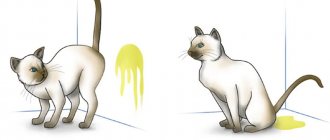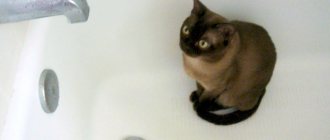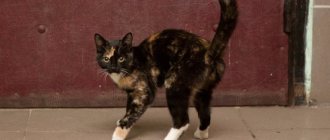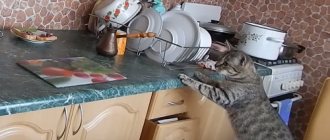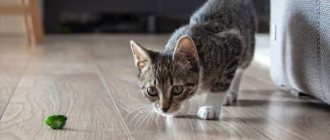Peeing in the tray and pooping next to it - what is the reason?
Tailed fluffies know how to surprise with their ingenuity and skills, but sometimes their owners receive truly unpleasant surprises from them. Although cats are considered one of the cleanest animals, they also have strange embarrassments - the pet relieves itself in the tray, but prefers to poop by.
Why does this happen, is it worth punishing this cat, or should we first figure out what motivates her to commit such an atypical act? The main reasons for this behavior in cats:
- various diseases;
- prolonged constipation;
- instincts;
- preference for certain toilet fillers;
- psychological problems;
- cleanliness issues.
No matter how paradoxical it may sound, the reason that a cat pees in the litter box and poops past it is the absolute cleanliness of the animal. Some cats are so protective of their cleanliness that they will not go into a litter box that is not regularly treated with antiseptic agents.
If a cat pees in the litter box and poops past it, the first thing the owner is recommended to do is to carefully ensure that the toilet is always clean and does not contain foreign, unpleasant odors. To do this, just treat the tray with vinegar.
Methods of influence
In the fight against uncleanliness, there are a number of other ways to stop a cat from shitting in the wrong place:
- Method of imprisonment. When a cat is left alone during the day or at night, limit its space to one room, where there is a tray, bowls with food and water. Thus, as if forcing the use of a pallet. It shouldn't be a room where she gets dirty.
- Supervision. If the owner has time, then it is possible to wean off crap using constant monitoring. The animal goes into another room, the owner follows. The cat sits down to urinate, the owner needs to stop him or distract him. To do this, small nails or peas (buckwheat) are poured into a plastic jar and when the pet settles down to defecate, the jar is thrown into that part of the room, but not into the animal. Cats are afraid of noise, they will try to avoid this place where it is scary.
- Cleaning the place. It is equally important to thoroughly wash the area where the animal gets dirty. You need to choose the right product to treat the area with. There are many commercially available substances that remove urine and odor from feces. Better is one that not only removes the odor, but contains enzymes that decompose urine and excrement. Do not use bleach or any substances containing ammonia. The latter enhances the smell of urine.
- Change the purpose of the place. To prevent the cat from spoiling, the owner needs to limit access to the places that she has chosen for her business and make them unattractive for getting dirty:
- The cat likes the carpet, so you need to turn it over to the other side.
- Place double-sided tape on the floor where it leaves puddles and piles.
- Spray with a liquid with a citrus aroma, it has a repellent effect or store-bought Antigadin.
- To prevent people from crap in the corners, they are blocked off with large-sized furniture and other fences. You can cover the corner with foil or plastic.
- People are weaned off the bathtub and sink by leaving a little water there.
- If a cat shits in a flower pot and it’s definitely not the filler, you can cover it with foil or put some boards on it. The main thing is to deny access to land. From folk remedies, you can put orange or tangerine peels in a flowerpot.
- The smell of citrus fruits will also repel you from the garden beds. According to reviews from gardeners, cats stop burying their feces in beds sprinkled with hot pepper. The smell of vinegar, garlic, essential oils of lemongrass, rosemary, lavender, and strong perfume are also repellent.
- There are special ultrasonic repellers that can be used outdoors to keep them away from garden beds and in rooms. However, such devices can make cats fear their own home.
Repellents are chosen individually, since animals have different preferences.
We exclude medicine
If the tray is always clean and smells quite pleasant, then why does the animal still not change its habit of ignoring it, defecating past it, as if out of spite? In this case, it is worth observing the animal, perhaps the development of various diseases is to blame.
The most common cause of strange cat behavior is the presence of frequent constipation in the pet. The cat begins to associate his toilet with unpleasant, uncomfortable sensations, which is why he prefers not to go to it.
Another reason for this behavior is related to the age of the cat - quite often older cats develop a disease such as arthritis. Due to joint pain and stiffness, they are simply unable to perch on a tray with high sides.
In addition, there are also psychological factors, for example, when the owner uses a closed house as a cat litter box. Of course, it looks interesting and aesthetically pleasing, it traps odors, but in most cases cats feel uncomfortable and uncomfortable in such houses, so they prefer to ignore it.
Causes
First of all, you need to get rid of the anger that arises in you after you notice another pile of feces in the corner. After all, only after understanding the fluffy one can you begin to solve the problem.
Physiological
Hyperthyroidism
It is extremely difficult to recognize the symptoms of this pathology, and this is due to the fact that the disease affects many aspects of a cat’s life. Signs of hyperthyroidism:
- Cardiopalmus.
- Frequent urination.
- Digestive problems (diarrhea or constipation).
- Increased appetite combined with weight loss.
- Aggressiveness.
Kittens
Cystitis
Often this disease develops due to sitting in drafts. This is due to the fact that pathogenic microorganisms in the urethra are able to actively multiply at low body temperature. When the disease begins to develop, the cat may become dehydrated (he constantly approaches the bowl of water).
It is important to immediately take your pet to the clinic when you notice the first symptoms.
Since an advanced disease can turn into a chronic form, which is practically untreatable. A severe form of cystitis is easy to recognize, as the urine becomes dark brown in color.
Urolithiasis disease
Urolithiasis is the most common disease occurring between 5 and 7 years of age. The following factors usually contribute to the development of this pathology:
- Problems with the gastrointestinal tract.
- Unbalanced diet.
- Hereditary predisposition.
- Food with excess protein.
- Indigestion.
- Hormonal disbalance.
- Lack of vitamins of group A.
The cat was offended
Psychological
Cats always perceive your home as their own territory. Therefore, if strangers or animals enter this territory, this causes severe stress for the animal. If the pet does not have various diseases, then most likely the cat has stopped using the toilet precisely for psychological reasons.
Manifestation of cat instincts
Some pets' natural instincts are so pronounced that they cannot relieve themselves of small and large needs in one place.
This is explained by the fact that cats associate the process of urination with the process of marking their territory, which is why they begin to walk past the litter box when defecating.
How to get out of this situation? It is recommended to place two litter boxes for your pet, but not next to each other (this arrangement of toilets will not solve the problem), but at some distance - these can be different corners of the same room, and sometimes even different rooms. Only trial and error will help you achieve the ideal placement of two toilets.
Methods to Avoid
When implementing a plan on how to wean a cat from shitting in the wrong place, you cannot use this method as punishment: neither scolding nor physically. The animal will associate the punishment with the owner, and not with the action, which is why the relationship will change for the worse.
A cat that has just settled down to relieve its needs in an unauthorized place can be scared away by making noise at it, but not using force. Then calm the animal and take it to the tray. But it is useless to make noise when caught after the “crime”, when she is burying excrement, since she will not form any associations.
Wrong filler
Cats are self-sufficient and fastidious animals. Often the reason that a pet categorically refuses to go to the litter tray is that the owner does not like the litter chosen by the owner. At the same time, even in the filler he doesn’t like, he will still write.
This is explained by the fact that the animal spends much less time on the process of urination than on defecation. Therefore, if the cat is uncomfortable with its paws immersed in the litter for some time, it will walk past the tray. It is easy to solve this problem - just change the type of cat litter.
Medical problems
Unfortunately, even young cats can have problems with their kidneys, liver, and gastrointestinal tract, and litter box problems are the most obvious symptom. It simply hurts for an animal to go to the toilet, and therefore she will look for the most comfortable place. In this case, a visit to the clinic for a biochemical blood test will be required. In this case, the pet will not be fed for at least eight hours before the test visit.
Despite prevailing stereotypes, territory can be marked not only by males and not only by urine. The body of females is designed in such a way that without reproduction they experience a hormonal imbalance, which has a significant impact on their behavior. The only best option in such a situation would be to sterilize the animal.
Safety
When a cat relieves itself, at this moment it is as unprotected as possible, therefore, if it is uncomfortable on the tray, there is no feeling of security, it will prefer to ignore trips to its toilet. To save space, owners often place cat litter boxes in too secluded, dark places, such as niches. Or the tray is squeezed into the tight space between the bathroom washing machine and the wall.
If your pet feels uncomfortable on the tray, don’t be surprised that he will simply start to ignore it.
The cat litter box should be located so that the cat has several approaches to it, and from different sides. In addition, there should be enough space around it.
The main reasons why cats shit in inappropriate places
The furry creatures torment their owners with their bad habit with depressing consistency or from time to time. As a rule, this is explained by the following factors:
- the cat is not litter box trained;
- the cat does not like the place where the tray is installed;
- the cat has complaints about the shape or filling of the tray;
- the tray is dirty;
- Competitors living in the house claim the tray;
- the cat is stressed;
- the cat has health problems;
- age problems;
- the cat wants to go for a walk.
Depending on the reason, you should choose a method by which you can ensure order and cleanliness in the house.
When do kittens start pooping and how many times a day should they do it?
A kitten's health directly depends on whether its digestive system is functioning properly. The process of relieving itself becomes a kind of detector of the animal’s condition.
The frequency of the urge to defecate in kittens is associated not only with their age, but also with their diet and the functioning of their digestive organs.
Problems with a baby’s stool are completely solvable; the main thing is to identify them in time, knowing the peculiarities of the kitten’s development.
- 1. How kittens defecate from birth to three to four weeks
- 2. From three to four weeks to three months
- 3. Defecation of kittens from three months
1 How kittens defecate from birth to three to four weeks
Some owners are sure that cats do not know how to relieve themselves until they are 3-4 weeks old. This is not true, kittens begin to poop and pee from birth, but until they are one month old they do this with their mother’s help.
While licking the baby, the cat massages its tummy, stimulating blood circulation in the digestive organs. The mother removes the kitten's waste products using her tongue. The feces of an animal at this age are homogeneous, with a consistency reminiscent of condensed milk.
We recommend
How to properly use wood cat litter
1.1 When the cat doesn't help
If a cat for some reason cannot or does not want to help her cub, the kitten’s tummy, overfilled with feces and intestinal gases, swells, causing pain.
Instead of the mother, the owner will have to help the animal. To do this, you first need to massage your baby's tummy in a clockwise circular motion. Then use a piece of gauze soaked in warm water to massage his anus.
If the owners have to feed the baby instead of the cat, they should not forget that at this age only liquid or semi-liquid food is suitable. The best option is a special mixture from a veterinary pharmacy.
We recommend
Antigadin for cats: a review of the best drugs and the use of improvised means
2 From three to four weeks to three months
From about one month of age, kittens are accustomed to food intended for adult animals. Then the kids begin to go to the toilet, both big and small, on their own, without mother’s help. The owners’ task at this time is to teach the kittens to relieve themselves in the litter box.
Owners do not always notice that their pet is looking for a place where it would be convenient for him to relieve his natural needs. Determining that a kitten has decided to go to the toilet is quite simple:
- sniffs the space around him;
- scrapes his paws on the floor.
As soon as these signs are observed in the kitten's behavior, it should be immediately transferred to the tray. The baby should get used to it the first time.
During this period of life, kittens go to the toilet three to six times a day. They often do this unnoticed.
It is very difficult to calculate the exact number of bowel movements at this age, but if the baby is active and his tummy feels soft to the touch, then everything is in order. The feces of a one-month-old kitten are mushy.
It should not contain undigested food debris, mucus or blood. In no case should it be too thick or liquid.
We recommend
Advantages and disadvantages of silica gel cat litter
3 Defecation of kittens from three months
By the age of three months, the kitten must be completely switched to food intended for an adult animal. His stool will become thicker and harder and will no longer resemble a homogeneous mass.
The number of trips to the toilet at this age depends on what the growing cat eats. If his diet consists mainly of plant foods, he will often find it easier to walk.
If the kitten has not pooped for several days, the owners should worry. You can try to help yourself:
- massage your stomach;
- make a microenema;
- add a little vegetable oil to the feed.
If all this does not help, you need to contact a specialist.
Problems with stool in kittens often arise due to stress and constipation. A baby separated from its mother sometimes experiences difficulty going to the toilet for 5 days. As soon as he calms down and gets used to his new place of residence, the situation will resolve itself.
How often a kitten should urinate depends solely on how much he drinks. A baby will pee more often than an adult because he has a smaller bladder.
It is important to monitor the quality of urine, its color and the absence of discomfort when relieving yourself.
How to wean it and what to do?
Each specific reason for a pet’s inappropriate behavior requires its own solution.
If you don't like the tray
Method one: improving the tray.
We check the sides, the size of the tray, and its cleanliness. We're setting up a second tray so that there are two - separate for big and small things. We remove the tray from a walk-through, crowded place, away from the bowl of food and the “dormitory building”. For particularly shy people, you can try to have a closed toilet-house.
We check the sides, the size of the tray, its cleanliness
Pay close attention to the filler. Perhaps there is something wrong with him. Try a different look and type. For example, replace wood with clay, clay with silica gel or regular sand or newspaper.
Method two: “compromising” the place that the cat has adapted for the toilet.
To do this, put foil or a wet rag there, or place a bowl of water. You can catch the moment when the animal “settles in” and spray it with water from a spray bottle. For some time, the frightened hooligan will avoid the “scary” place. There is a chance that he will forget about him completely.
Method three: move the tray to a place that the animal has chosen, or place several temporary containers in “memorable places”, lay down paper towels and napkins. The main thing is that the pet does not shit on the floor.
Note: it is useless to punish a pet for an expired crime. You can hit him with a wet rag, if only he is caught red-handed.
If the problem is health
Treatment prescribed by a veterinarian will eliminate the pain and return the pet to the litter box. If the animal is old and it is difficult for him to get to the toilet, you should show understanding and place the tray within walking distance of the pet.
Sometimes you want to kill them
If the cat marks
In this case, comprehensive measures will be needed:
- relieving excitement, nervousness, reducing sexual activity with the help of special drugs, for example, “Cat Bayun”;
Note: it is useless to spray the marks with odorous substances or various “anti-gaspers”. The cat will only mark more actively in order to kill the “alien” smell. You can remove the mark with a neutralizer such as vinegar or vodka. Cats can't stand them.
- restricting the animal's access to marking sites;
- using a diaper. Spending most of the day in a diaper, the animal gradually weanes itself from marking;
- mating a cat - after pregnancy, hormonal levels are restored;
- sterilization of animals.
Advice: if there are two cats in the house and there is an active dispute over territory, you should, if possible, separate the zones of influence and provide the cats with separate trays. The competition factor is also removed by separate feeding at different times.
If the cat takes revenge
Demonstration heaps and puddles - on the bed, sofa - evidence of a pet that has been offended in its best feelings. In this case, breeders advise treating critical areas with vinegar (diluted half with water) and covering the bed/sofa with plastic wrap, newspapers, or something prickly and rough.
If cat waste products begin to appear in flower pots, then the most obvious way to combat this harmful phenomenon is to lift the pot from the floor and place it out of the cat’s reach. And offer the animal a replacement in the form of temporary trays/cans/bowls. To prevent a hooligan from wanting to test the resistance of the owner's shoes against leaks, you should temporarily remove the shoes from the floor into the closet.
Demonstration heaps and puddles - on the bed, sofa - evidence of a pet offended in its best feelings
It is also necessary to limit the cat’s access to the scenes of such crimes - close the room or take the animal into custody, put it in a cage while the owners are not at home. For these purposes, breeders highly recommend spacious exhibition cages.
The bondage method often works. As soon as the pet intends to make its “pee-pee” in the wrong place, immediately send it to the cage - with the company of the tray. 2-3 weeks of such imprisonment and the cat gives up.
Psychological moments
Psychological problems that provoke a pet to shit anywhere can be eliminated only with love, patience and affection. You need to establish a relationship with an “upset” cat. Do not scold, do not beat, but press for pity. Housewives are not forbidden to shed a tear to show their pet how upset she is. You can talk about life, complain about difficulties, stroking and scratching the “asshole” behind the ear. And so on day after day, without breaking into screaming and yelling, until trust in the owner’s boundless love returns to the offended cat’s soul.
In addition to psychological conversations, active games and fun with your pet help. A few toys and a paper bow on a string can work wonders.
It is better to play active games with your pet before he does “bad things” on the carpet or in another unauthorized place. Running around, happy with the owner's attention, he will not spoil the impression of himself.

